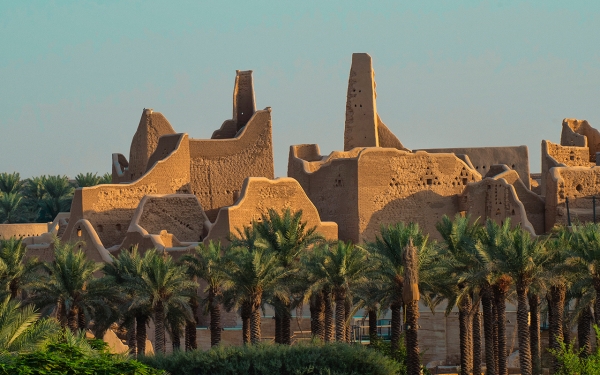
Al-Turaif is a historical district in the heart of Diriyah in Riyadh, Kingdom of Saudi Arabia. It was built in the middle of the eighteenth century, and is one of the biggest mud cities in the world. It is home to Salwa Palace, which was the seat of the First Saudi State, and Imam Mohammed bin Saud Mosque, the largest mosque in the First Saudi State at the time. The mosque's construction dates back to the reign of Imam Abdulaziz bin Mohammed bin Saud, the second Imam of the First Saudi State who assumed power in 1765. The district includes a number of historical landmarks, among them about 13 palaces of the royal family members, and it contains a number of mosques, government buildings, and humanitarian facilities.
Al-Turaif District's historical importance
The imams of the First Saudi State settled in this historical district, starting with Imam Abdulaziz bin Mohammed bin Saud. During his reign, Al-Turaif District flourished. On the other hand, by the end of Imam Abdullah bin Saud's reign, the district was shaken by the attack of the Ottoman forces led by Ibrahim Pasha, which besieged Diriyah for six months in 1818. At the end of his siege of Diriyah, Ibrahim Pasha directed his cannons, which were manned by European engineers, towards Al-Turaif, where Imam Abdullah bin Saud resided, because the district was seen as the last fortress to defend Diriyah and the state. Although Ibrahim Pasha was able to destroy the district, the latter survived the attack, and large parts of its buildings were still standing due their powerful construction.
Al-Turaif District joins the UNESCO List
Al-Turaif District is the second Saudi site that was added to the List of UNESCO World Heritage Sites in 2010 after Hegra. The Custodian of the Two Holy Mosques King Salman bin Abdulaziz al-Saud spared no effort to preserve Al-Turaif District and develop historical Diriyah, as Chairman of the High Executive Committee for Diriyah Development in the Royal Commission for Riyadh City when he was Crown Prince of Riyadh in 1998. Crown Prince and Prime Minister, His Royal Highness Prince Mohammed bin Salman bin Abdulaziz al-Saud was also concerned with Al-Turaif. He developed an advanced program for the district within the activities of Diriyah Gate Development Authority, in which he served as the Chairman of its Board of Directors.
Development of Al-Turaif historical district
In 2018, the Custodian of the Two Holy Mosques King Salman bin Abdulaziz, inaugurated Al-Turaif historical district after its development with the aim of turning it into an international tourist and cultural center, given its historical, cultural, urban and environmental characteristics, in addition to adding it to the list of World Heritage Cities. In 2022, the historical district began receiving visitors.
Al-Turaif historical district museums
Al-Turaif District houses several museums, most notably the Diriyah Museum in Salwa Palace, which showcases the history of the First Saudi State and its characteristics in governance and administration. The museum uses visual displays and a number of paintings and holograms that tell the story of the palace, and the time period during which it was used as the seat of the government. The Social Life Museum focuses on the daily life of Al-Turaif people and highlights their traditions and customs. Furthermore, the museum displays the tools and utensils that were used for different domestic purposes during the reign of the First Saudi State. On the other hand, the Military Museum showcases the weapons that were used in wars and battles, and documents Diriyah's historical defense story before the city fell.
The Arabian Horse Museum in Al-Turaif District sheds light on the Saudi Royal family's interest in purebred Arabian horses. Furthermore, it shows how the horses were taken care of when Diriyah was most prosperous, in addition to the places which were used as stables at the time. The Museum of Treasury, which was historically the location of Bayt al-mal (House of money), displays the currencies, endowments, scales, trade methods, as well as the economic development witnessed by Diriyah.
Related quizzes
Related articles

